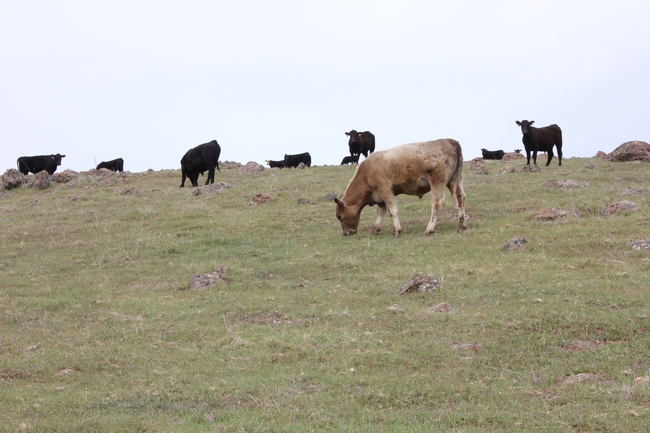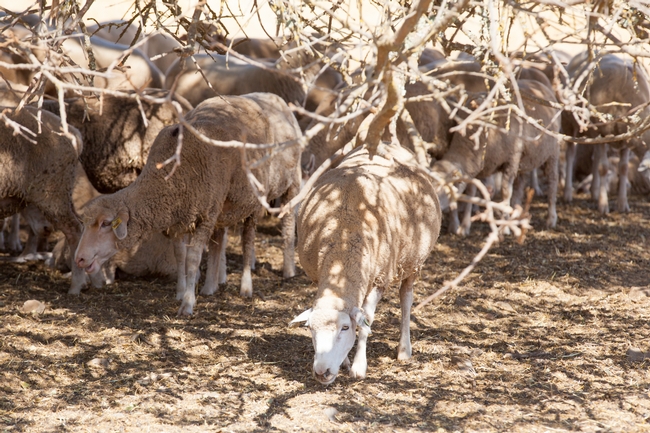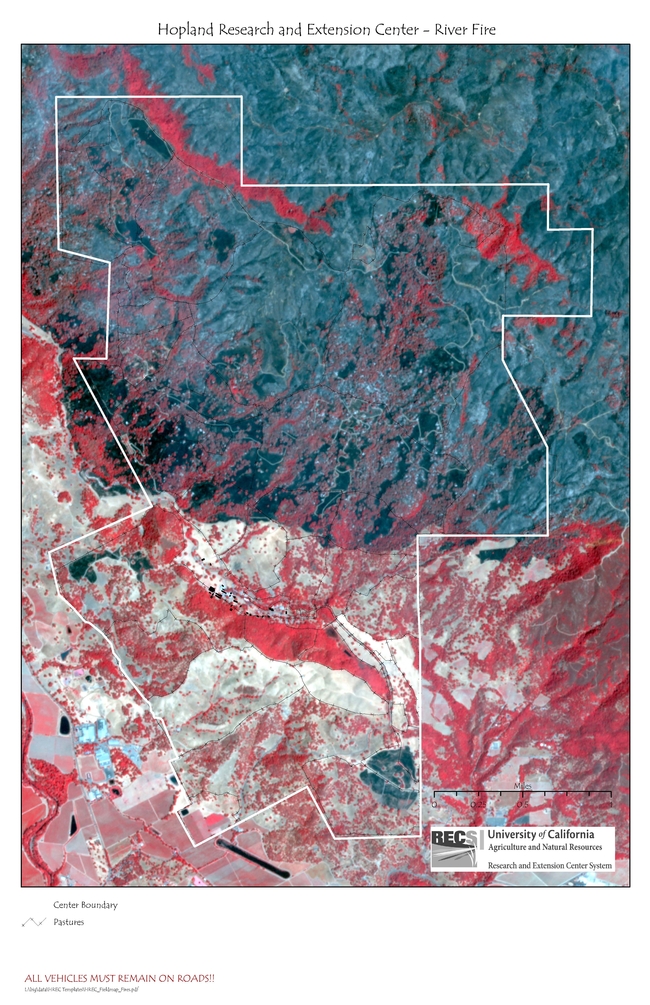
Posts Tagged: Rangeland Management
Changes to UC ANR Hopland REC Sheep Program
UC Hopland REC Reduce Sheep Flock
For over 65 years, the Hopland Research and Extension Center (HREC) has been well known as one of the last large scale sheep ranches and research facilities in the northwest. Their woolly forms are a familiar sight against the backdrop of the 5,358 acre site, well loved by the community for school field trips during the lambing season and for the sheepdog trials during the fall. In addition, they have a long history of being on the forefront of emerging research and management strategies related to sheep for topics such as: sheep biology and management, rangeland management, livestock/predator/wildlife interactions, as well as grazing as a tool for vineyard owners, fire prevention, and noxious weed control.
This summer the HREC flock will be reduced from 500 breeding ewes to approximately 125 and their full time shepherd position will be cut. The sheep will be sold at auction on the site (4070 University Road, Hopland, CA) on June 3. The sale will allow sealed bids from 8am-11am, with a minimum lot size of 20 animals. This reduction echoes a change that can been seen across the state in flock size and management styles.
Agriculture moves in cycles, following both the seasons and market demands. The sheep population in Mendocino County has fallen from 140,000 in 1954 (UCANR) to 10,400 in 2018 (USDA), and statewide sheep numbers have fallen from 2,034,000 in 1954 (UCANR) to 550,000 at the end of 2018 (USDA). As California flock numbers have declined, so has sheep research interest and funding.
Magnifying the impact of these changes, HREC is facing a significant reduction in funding from the University of California system. HREC is one of nine Research and Extension Centers (RECs) under the University of California Agriculture and Natural Resources (UC ANR) division which has seen significant budget challenges in the last few years due to flat state funding. Overall, budget reductions of $3.1 million from central (ANR) funding across the REC system are planned, and HREC's share of these cuts will amount to over 30% of its budget. The scale of this budget reduction is driving a statewide reevaluation of priorities and strategic decisions about where ANR should allocate limited funds to best meet its mission of strengthening the health of California's people, communities, food systems, and environment.
“While we must strategically adjust to financial realities and changes in research and extension priorities, we are sad to see the flock reduced and to face the coming loss of our dedicated and talented shepherd Jim Lewers. The smaller HREC flock will continue to fulfill an important role at the site, allowing us to continue to offer sheep focused educational programs and events, and to share our experience and research with sheep owners. The flock is a key tool in reducing the risk of wildfire through grazing for fire fuel reduction. Targeted grazing also helps to reduce invasive species and provides food and fiber. We plan to continue to welcome our community youth to “meet the lambs” and celebrate the services and products provided from the HREC flock at our events, for example our Wool Growers Field Day which takes place on June 1” said John Bailey, Interim Director at HREC. “We are also working to pivot our livestock programs to meet a broad array of identified research and extension needs. This will include working with private producers and potential diversifying into other species such as cattle.”
Although sheep have been considered a core feature of HREC, many other aspects of natural resource management and education are offered at the site. The diverse landscape offers oak woodland, chaparral, and riparian areas, as well as the ability to compare areas affected and unaffected by the 2018 River Fire. This landscape provides an important site for researchers from across the University of California system and beyond to study diverse aspects of the ecosystem services and working landscapes that makes California the wonderfully productive and diverse state that it is. Currently 19 research projects are studying topics including: climate change effects on soils and oaks: to tick-borne diseases: to wildlife ecology and management: rangeland ecology: fire science and sustainable land management practices.
In addition to diverse research opportunities, HRECs Community Education Specialist, Hannah Bird, has built and continues to develop a rich portfolio of extension and education events including workshops, field trips, and field classes. With the goal of educating and inspiring connection to and knowledge of diverse aspects of agriculture and natural resources, program offerings include not only sheep and wool focused events but also naturalist trainings, fire science education, birding trips, a youth summer camp, and extensive field trips which have brought over 2000 community members to the site in the past year.
“We are excited to share this wonderful site and extend the deep and broad knowledge which researchers and passionate individuals have developed about California ecosystems and agricultural systems. In this era of increasing focus on digital devices, we offer an alternative of hands-on, science-based educational opportunities for youth and people of all ages to engage with and deepen their love for our rich environmental and agricultural heritage.”
Despite the system-wide budget challenges, HREC continues to build its research and educational programs. Donor support and grants have become an integral part of their future. “Over the last year, we have been successful in obtaining grant awards from the Environmental Protection Agency with our partner REC in the Sierra Foothills for $100,000 to support fire education for middle school youth and adults, local grants to support youth education from the Mendocino Community Foundation, and individual donors have supported us with over $18,000 in 2018. Never has there been a time when such support is more needed at HREC to help us to continue to fulfill our important role in northern California.” commented Bailey in closing.
For further information regarding the sheep sale on June 3rd please visit http://bit.ly/HRECSheep . For information regarding the Wool Growers Field Day on June 1st please visit http://bit.ly/WoolGrowers . To find out more about HREC or donate to their work visit: http://hrec.ucanr.edu/ or call Hannah at (707) 744 1424 ext 105.
URGENT: Post Fire Research Opportunities at Hopland REC
HREC and Post-Fire Research Opportunities
What is HREC?
The UC Hopland Research & Extension Center (HREC) is a multi-disciplinary research and education facility in Mendocino County located in the foothills of the Coast Range about two hours north of Berkeley. As part of the UC system for over 65 years, we are stewards of more than 5,300 acres of oak woodland, grassland, chaparral, and riparian environments. Elevation at the center ranges from 500 ft to 3,000 ft. HREC currently maintains a research flock of about 500 breeding ewes that have been the subjects of numerous studies on ranching practices, range management, livestock nutrition, wool production and breeding. Field experiments and demonstrations conducted here since 1951 have led to more than 1,500 publications in animal science, entomology, plant ecology, public health, watershed management, and wildlife biology. Our website is hrec.ucanr.edu.
The River Fire
As part of the Mendocino Complex fire, the River Fire burned through HREC on the evening of July 27 and into July 28. Approximately 3,000 acres of our center burned in this fire. Due to the concentrated efforts of Center staff and Cal Fire crews, all of our employees, residents, sheep, livestock dogs, offices and residences were saved. Below please find the burn map of our property. All of the black area to the north was burned and the dark red patches were areas of vegetation that remained unburned. The fire intensity varied greatly as did oak survival. You will see two smaller burned areas in the southern part of the property that were prescribed burns performed in June of this year.
Research Opportunities
While this was a blow to current research, pastures, and water infrastructure, we also see this as a wonderful opportunity. Due to extensive historical data sets and ongoing research projects, coupled with a variety of grazed and ungrazed pastures, and prescribed burn plots for comparison with wildfire, there is enormous potential for pre- and post-fire studies in the fields of:
- Watersheds and hydrology; fire science; plant science; soil science; entomology and parasitology; wildlife and wildlife ecology; rangeland management; grazing practices as fire suppression…..
To support this research, HREC offers:
- A well maintained network of roads that accesses almost all parts of the property, vehicles to use.
- A fully equipped shop staffed by employees skilled in fabrication and repair of research equipment
o Electrical, wood working, welding and metal fabrication, mechanical
- Skilled staff trained in field work techniques, with long histories of successful research support
- Fiber optic internet with Wi-Fi access throughout headquarters, strong cell service in most areas
- A vault of raw data, photos, and final papers from research conducted at HREC.
- Warehouses for storing equipment, a variety of accommodations from dorms to private houses
- Wet and dry lab space (undergoing renovation during fall 2018, available spring 2019)
- Lysimeter with available watering system, electrical connections, and fiber optic access point
- A research flock of sheep consisting of just under 500 breeding ewes, with all needed facilities and RFID tracking
- Fenced pastures and biological reserve areas for different treatment plots and controls
- A fully equipped conference facility with A/V equipment and fiber optic connections
Next Steps
- Zoom meeting on September 7th, 10am. More in depth information, Q&A.
- Field day on October 19th, 10am-5pm. Presentations, brainstorming, Q&A, site tours, available accommodations
- To register for either event follow this link: http://ucanr.edu/survey/survey.cfm?surveynumber=25451
Contact: HREC Interim Director John Bailey, jtbailey@ucanr.edu, (707) 744-1424 x 112
Living with Wildlife While Managing Working Landscapes: Presentations now available
On December 1st and 2nd we enjoyed bringing together a group of over 60 workshop attendees from diverse perspectives, including researchers, regulatory bodies, environmental non-profits and community members to talk through the issues of ranching on a landscape rich in wildlife and the challenges associated with it.
"Living with Wildlife While Managing Working Landscapes" was a two day event. Day 1 was organized by USDA APHIS Wildlife Services and brought us on a journey through the research that has been conducted on control of predators, right up to the present day and the current methods available including non-lethal methods such as guardian animals and fladry.
Day 2 allowed time for further discussion in small groups and the chance to hear from Mendocino County producers about the responsibility they feel to keep their animals safe and healthy for the duration of their lives on the ranch.
The event was a great success, allowing deeper understanding of what is sometimes an over simplified topic with strong emotion attached to it. As one attendee put it "what I realize after this event is that I knew nothing of this subject before it!"
The answers are not simple and the information provided expressed that each ranch is different and will need a wide range of tools to deter predators from their stock. That toolkit may include a relationship with Wildlife Services and their local wildlife specialist alongside guardian animals, minimizing attractants, improved fencing and pasture rotation. HREC hopes to assist ranchers to understand the best methods available to them that make both ecological and economical sense for their ranch by providing a number of training opportunities in 2016.
You can view the agenda, available presentations and notes from the small group discussions up on our website now, by visiting:
Low residual dry matter on rangeland a concern heading into wet season

With some recent forecasts bringing encouraging news about a potential El Niño, some ranchers have been asking about what they should expect in terms of forage production, if and when the rains come. What they want to know is how soon rangeland productivity will reach the pre-drought levels again. One issue that I always draw their attention to is the levels of residual dry matter (RDM) on the rangelands. Even with the reduction in herd sizes and shorter grazing seasons employed by most producers, more rangelands now have less than recommended RDM levels.
RDM is a measure of the old plant material (without counting summer annuals) that are left standing or on the ground before the fall precipitation comes. It is a great indicator of both forage production and grazing intensity. These leftover plant materials are critical on California rangelands to reduce erosion and nutrient loss, and to create a conducive environment for diverse plant communities to thrive. Optimum RDM levels are site specific, they range from 100-2,100 pounds per acre, and depend on precipitation zone, slope and tree canopy cover. Ideal RDM levels increases with precipitation and slope, and decreases with tree cover. Studies show that too low or too high RDM levels will reduce species composition and forage production, both factors critical to any livestock production system. The good news is that annual rangelands are resilient and will likely return to normal production within two years after bringing RDM level to recommended standards.
Knowing the RDM standards for one's rangeland and continuously monitoring is an important step towards achieving sustainable rangeland management and livestock production.
Details about RDM standards, data collection methods and more can be found in the free UC Agriculture and Natural Resources publication Guidelines for Residual Dry Matter on Coastal and Foothill Rangelands in California.
Author: Fadzayi Mashiri, Ph.D.
Research Spotlight: Impacts of Soil Warming on Organic Matter Decomposition
Impacts of soil warming and plant roots on organic matter decomposition in a Mediterranean grassland
Accurate understanding of soil carbon cycling is critical for predicting future climate. Decomposition of root litter and its transformation into soil organic matter are critical processes of soil carbon cycling. Thanks to support from the U.S. Department of Energy's Terrestrial Ecosystem Science program, a team led by Dr. Margaret Torn from Lawrence Berkeley National Laboratory have been studying the impacts of soil warming and plant rhizosphere on decomposition of 13C-labeled roots buried at two soil depths using a field lysimeter facility at Hopland Research and Extension Center, California.
The lysimeters contain soil columns of 38-cm diameter and 48-cm depth and annual grasses dominated by wild oats (Avena barbata). The experiment has three treatments (planted-ambient, planted-warming by 4°C, and unplanted-ambient). 13C-labeled Avena fatua roots were added to two depths (8-12 and 38-42 cm). The team will quantify the fate of added root litter in CO2 efflux from soil surface, dissolved organic carbon (DOC) leached from the bottom drain, and organic carbon remaining in bulk soil and different physical fractions for two growing seasons.
First season results show strong role of soil moisture in controlling soil carbon cycling in this Mediterranean ecosystem. Soil warming enhanced plant growth and ecosystem respiration in the early growing season with high soil moisture, while it suppressed plant growth and ecosystem respiration in the late growing season when soil moisture was limited. The team will continue measurements on CO2 flux, DOC loss, and organic carbon recovery in soil fractions, as well as collaborate with microbial ecologists and ecosystem modelers to better understand the underlying processes and to improve the models used for prediction of our future climate.



